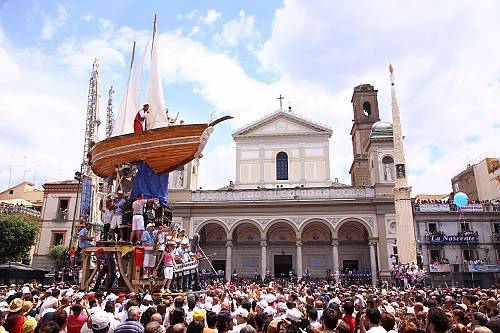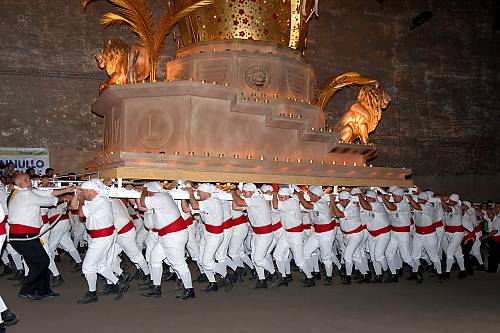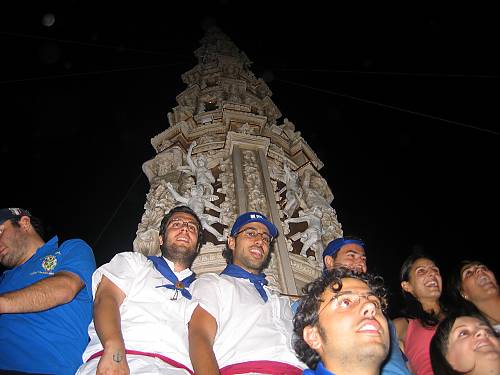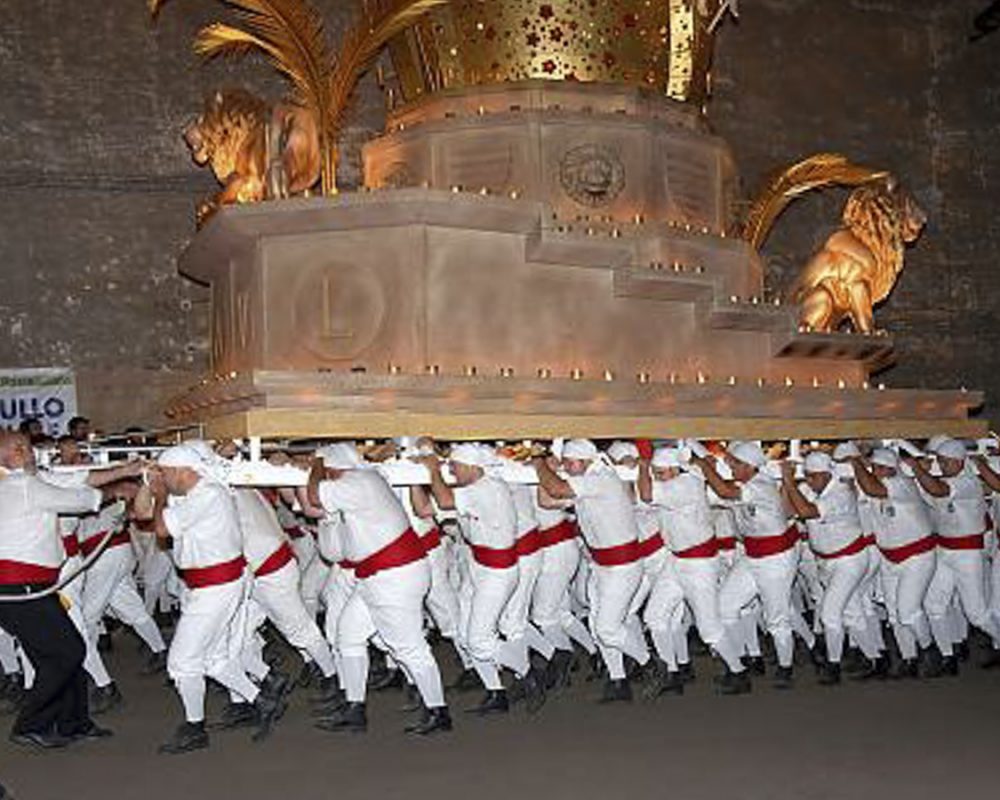Inscribed in 2013 (8.COM) on the Representative List of the Intangible Cultural Heritage of Humanity
1.1 Description of the element
Catholic processions featuring large shoulder-borne processional structures take place throughout Italy, but particularly in four historic city centres: in Nola, a procession of eight wood and papier mâché obelisks commemorates the return of St Paolino; in Palmi, bearers carry a complex processional structure in honour of Our Lady of the Holy Letter; in Sassari, the Discesa dei Candelieri (Descent of the Candlesticks) involves the votive transportation of wooden obelisks; and in Viterbo, the Macchina di Santa Rosa (Tower of Santa Rosa) commemorates the town’s patron saint. The coordinated and equitable sharing of tasks in a common project is a fundamental part of the celebrations, which bind the communities together through the consolidation of mutual respect, cooperation and joint effort.
Dialogue among the bearers who share this cultural heritage also results in the development of an exchange network. The celebrations require the involvement of musicians and singers, as well as skilled artisans who manufacture the processional structures and create the ceremonial clothes and artefacts. The festive communities rely on the informal transmission of these techniques and knowledge to recreate the structures every year, a process that aids cultural continuity and reinforces a strong sense of identity.
1.2 Geographical location and Range of the element:
The Celebrations of Big Shoulder-borne Processional Structures are located throughout the country, but the most representative events of this heritage take place in the historical city centers of four Italian cities: Nola, Palmi, Sassari, Viterbo; four cities of ancient origins, located in different Italian regions, whose geographical location deeply influenced their historical development, a history characterized by the exchanges facilitated by the Mediterranean basin. In the historical city center, communities, groups and individuals who hold the intangible cultural heritage operate. The use of big shoulder-borne processional structures, in fact, is linked to the ancient practice of ritual procession, which is the reason why the link between the votive structures transported and the urban architecture, is strong.
Historical city center of Nola (District of Naples – Campania);
Historical city center of Palmi (Reggio Calabria – Calabria);
Historical city center of Sassari (Sardinia);
Historical city center of Viterbo (Latium).
1.3 Domain(s) of the element
Domain(s) of the element as intangible cultural heritage identified according to the Article 2.2 of the Convention:
- oral traditions and expressions, including language as a vehicle of the intangible cultural heritage
- performing arts
- social practices, rituals and festive events
- knowledge and practices concerning nature and the universe
- traditional craftsmanship
- 0 other(s)
Evaluation Body Decision
Decision 8.COM 8.16
The Committee,
Takes note that Italy has nominated Celebrations of big shoulder-borne processional structures (No. 00721) for inscription on the Representative List of the Intangible Cultural Heritage of Humanity:
1. Decides that, from the information included in the file, the nomination satisfies the following criteria for inscription on the Representative List:
R.1: Recreated periodically in four Italian cities, celebrations of processional structures provide their communities of practitioners a sense of identity and belonging and strengthen social cohesion;
R.2: Inscription of the element on the Representative List could encourage dialogue among its practitioners in four cities and others, while promoting cultural diversity and testifying to human creativity;
R.3: Safeguarding measures proposed include documentation and research, promotion and awareness-raising campaigns as well as education programmes;
R.4: A series of meetings and seminars were organized with the participation of representatives of the four communities who gave their free, prior and informed consent;
R.5: The element is included upon initiative of the communities concerned in the General Catalogue of cultural heritage maintained by the Central Institute for Cataloguing and Documentation, under the Ministry of National Heritage and Culture.
2. Inscribes Celebrations of big shoulder-borne processional structures on the Representative List of the Intangible Cultural Heritage of Humanity.





